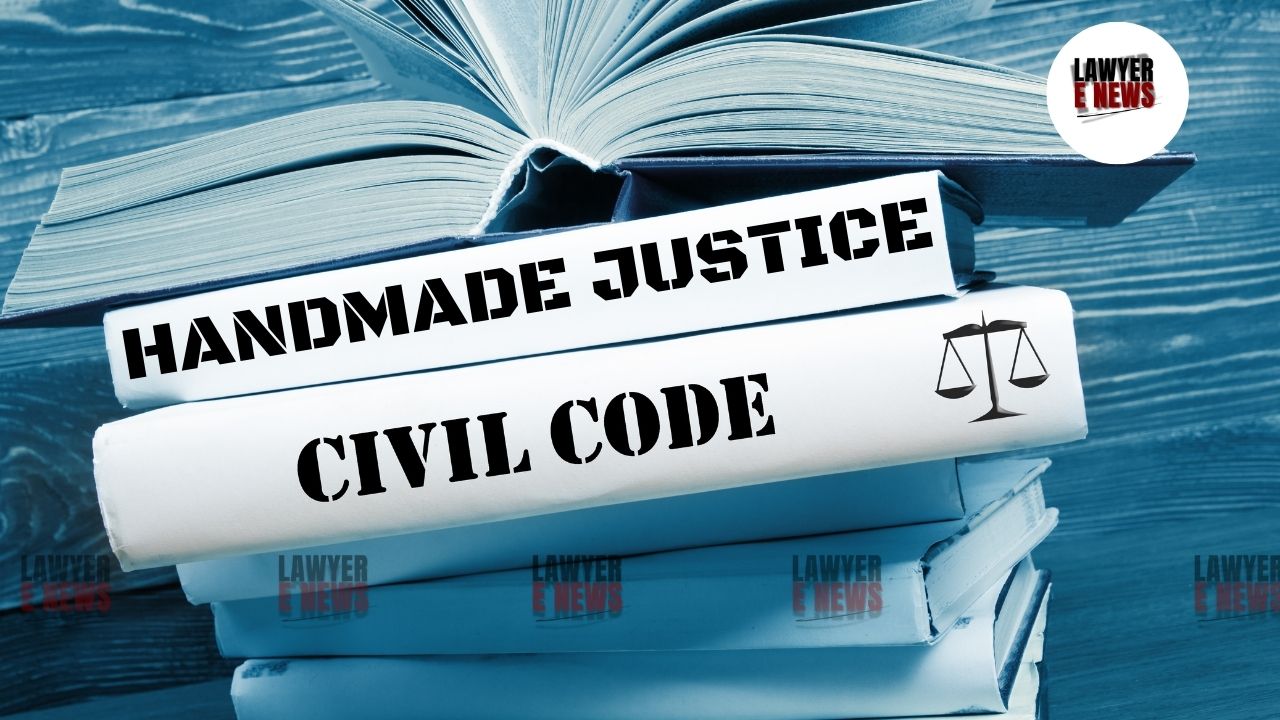


The Indian legal system, with its roots in colonial jurisprudence, has evolved over centuries to form a robust and intricate system of justice. One of the cornerstones of this legal framework is the Civil Procedure Code, 1908 (CPC). This code, often referred to as the procedural bible for civil matters in India, is the comprehensive law that governs the procedure for the administration of civil litigation. While the substantive law determines the rights and liabilities of the parties, the CPC provides the machinery to enforce these rights and liabilities through the courts.
The phrase "Handmade Justice" in the context of the Civil Procedure Code, 1908, metaphorically represents the painstaking and meticulous process through which justice is crafted in Indian civil courts. Unlike criminal law, where the state is the prosecuting entity, civil law primarily deals with disputes between individuals or organizations. The CPC ensures that these disputes are adjudicated with fairness, consistency, and adherence to the principles of natural justice. This blog delves into the nuances of the CPC, its historical evolution, key provisions, and the concept of "Handmade Justice" in the Indian judiciary.
Historical Evolution of the Civil Procedure Code, 1908
The CPC has a rich history, tracing its origins to the British colonial era. The first comprehensive code of civil procedure was enacted in 1859 by the British Government, which laid the foundation for civil litigation in India. However, this code had several limitations and inconsistencies, leading to its replacement by the present code in 1908.
The 1908 code was a significant improvement over its predecessor, incorporating the experience gained over decades of judicial administration. It was designed to provide a uniform procedure for civil courts across India, ensuring that justice was administered in a systematic and predictable manner. Over the years, the CPC has undergone several amendments to address the changing needs of society and to improve the efficiency of the judicial process.
Structure and Key Provisions of the Civil Procedure Code, 1908
The Civil Procedure Code is divided into two parts: the first part contains 158 sections, and the second part consists of 51 Orders that deal with various procedures related to civil litigation. The sections lay down the general principles, while the Orders and Rules specify the detailed procedures.
Jurisdiction and Res Judicata: The CPC lays down the rules regarding the jurisdiction of civil courts. Jurisdiction is a foundational aspect of any litigation, as it determines the authority of a court to hear a case. The doctrine of res judicata, codified under Section 11, prevents the re-litigation of matters that have been adjudicated by a competent court, ensuring finality in judicial decisions.
Pleadings: The code emphasizes the importance of clear and precise pleadings. The plaint (filed by the plaintiff) and the written statement (filed by the defendant) form the basis of a civil trial. These documents outline the facts of the case, the issues in dispute, and the relief sought by the parties.
Interim Reliefs: The CPC provides for various interim reliefs that can be granted by the courts during the pendency of a trial. These include temporary injunctions, attachment before judgment, and the appointment of a receiver. Interim reliefs are crucial in preventing irreparable harm to a party and preserving the status quo until the final resolution of the dispute.
Discovery and Inspection: The process of discovery allows parties to obtain evidence from each other to prepare for trial. This includes the production of documents, the examination of witnesses, and the inspection of properties. The CPC ensures that both parties have access to relevant information, thereby promoting transparency and fairness.
Execution of Decrees: One of the most critical aspects of civil litigation is the execution of decrees. The CPC provides detailed procedures for the enforcement of judgments, including the attachment and sale of property, arrest and detention in civil prison, and the appointment of a receiver. The effective execution of decrees is essential for the realization of justice.
Appeals, Review, and Revision: The CPC allows for appeals, reviews, and revisions, providing a mechanism for correcting errors in judicial decisions. This multi-tiered appellate system ensures that parties have the opportunity to challenge the decisions of lower courts before higher authorities, thus reinforcing the credibility of the judicial process.
Handmade Justice: The Crafting of Fair Outcomes
The concept of "Handmade Justice" in the context of the Civil Procedure Code, 1908, highlights the careful and deliberate approach that the judiciary adopts in civil litigation. Unlike automated processes, the dispensation of justice under the CPC involves human judgment, discretion, and interpretation. Each case is unique, with its own set of facts, evidence, and legal issues, requiring judges to meticulously analyze and apply the law.
The Role of Judges
Judges play a pivotal role in the administration of justice under the CPC. They are the custodians of the legal process, ensuring that the proceedings are conducted in accordance with the law and that the rights of the parties are protected. The CPC grants judges the discretion to interpret the law, manage the conduct of trials, and make decisions based on the merits of each case.
Judicial discretion is particularly evident in matters such as granting interim reliefs, framing issues, and deciding on the admissibility of evidence. The ability of judges to adapt the procedural rules to the specific circumstances of a case is what makes the process "handmade." It requires a deep understanding of the law, a commitment to fairness, and the ability to balance the competing interests of the parties.
Case Management and Timely Justice
One of the criticisms of the Indian judicial system has been the delays in the resolution of civil disputes. The CPC has several provisions aimed at reducing delays and promoting the efficient management of cases. The introduction of case management practices, timelines for the completion of various stages of a trial, and penalties for frivolous litigation are some of the measures designed to expedite the judicial process.
Despite these provisions, the effective implementation of case management practices often depends on the proactive role of judges. Judges must take the lead in setting timelines, enforcing procedural rules, and ensuring that cases progress without unnecessary delays. This active case management is a key component of "Handmade Justice," as it involves the hands-on involvement of judges in the administration of the trial.
Balancing Procedural Technicalities with Substantive Justice
The CPC is a procedural law, and as such, it is designed to ensure that the process of litigation is conducted in an orderly and predictable manner. However, there are instances where strict adherence to procedural rules may lead to injustice. In such cases, the judiciary has the discretion to prioritize substantive justice over procedural technicalities.
For example, the principle of "substantial justice" allows courts to overlook minor procedural defects if they do not affect the merits of the case. This principle is embodied in Section 151 of the CPC, which grants courts the inherent power to make orders necessary for the ends of justice or to prevent the abuse of the process of the court.
The ability to strike a balance between procedural rules and the overarching goal of justice is a hallmark of "Handmade Justice." It requires judges to exercise their discretion wisely, ensuring that the process does not become an end in itself, but a means to achieve fair and just outcomes.
Challenges and Reforms in the Civil Procedure Code
While the Civil Procedure Code, 1908, has been instrumental in shaping the Indian civil justice system, it is not without its challenges. The complexity of the procedural rules, the backlog of cases, and the limited resources of the judiciary have often been cited as impediments to the timely and effective delivery of justice.
The Backlog of Cases
One of the most pressing challenges facing the Indian judiciary is the backlog of cases. The sheer volume of pending cases has placed a significant strain on the judicial system, leading to delays in the resolution of disputes. The CPC, with its detailed procedural requirements, can sometimes contribute to these delays, particularly in cases where parties exploit the process to prolong litigation.
Procedural Complexity
The CPC is a comprehensive and detailed code, which, while necessary for ensuring consistency and fairness, can also be daunting for litigants and even legal practitioners. The complexity of the procedural rules can lead to confusion, mistakes, and inadvertent non-compliance, resulting in further delays and increased costs for the parties.
Judicial Reforms
In response to these challenges, there have been ongoing efforts to reform the Civil Procedure Code to make it more efficient and accessible. Amendments to the CPC have introduced measures such as alternative dispute resolution (ADR) mechanisms, summary procedures for certain types of cases, and stricter timelines for the completion of trials. These reforms aim to streamline the litigation process, reduce delays, and promote the quicker resolution of disputes.
The judiciary has also embraced technology, with the introduction of e-filing systems, virtual hearings, and digitization of court records. These technological advancements have the potential to significantly reduce the time and costs associated with civil litigation, making justice more accessible to the public.
The Future of Handmade Justice
The Civil Procedure Code, 1908, continues to be a vital instrument in the administration of civil justice in India. Its provisions, while rooted in the past, remain relevant in addressing the challenges of modern litigation. The concept of "Handmade Justice" reflects the judiciary's commitment to delivering justice through a careful and thoughtful application of the law.
As India progresses, the CPC must evolve to meet the changing needs of society. Reforms aimed at reducing delays, simplifying procedures, and leveraging technology will play a crucial role in ensuring that the judiciary can continue to craft fair and just outcomes for all litigants.